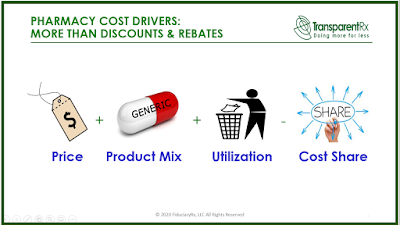Many PBM selection decisions come down to two things: comfort and price. Provided employers have done their due diligence, an employer’s comfort level with a PBM or its owner should take a back seat to the best candidate. Because PBM services have been commoditized, the best candidate should boil down to who delivers the lowest net cost.
Gasoline is a commodity. The gasoline at Speedway is largely the same as that pumped at Shell. You aren’t going to get better gas mileage or a cleaner engine buying gasoline at Shell but you will pay more. Hence, the claim being adjudicated by TransparentRx is the same as that at Optum, CVS or Express Scripts. Don’t let the flashy offices and talk about AI and machine learning fool you.
The price an employer pays for a prescription drug claim includes several components such as list prices, contractual discounts, fees and rebates. Price receives a lot of attention deservedly so. However, far too little attention is being paid to what matters most – cost.
 |
| Click to Learn More |
Product Mix refers to the complete range of products that is offered for dispensing by a pharmacy. In other words, brand, generic, specialty and biosimilar drugs make up product mix. Drug Utilization refers to the number of utilizers, days supply and channel mix for those drug products being dispensed by pharmacies. Cost Share is the member share of drug costs but that too is complicated and no longer as cut and dry as one might think.
Let’s take a quick look at how product mix might impact costs. Everyone knows that generic drugs are far less costly compared to brand drugs. But, did you know that for every 1% increase in GDR or generic dispense rate a plan sponsor can expect as much as a 2.5% decrease in ingredient costs? A non-fiduciary PBM is counting on you not knowing and that you will be mesmerized by their seemingly larger rebate and discount guarantees.
In the case of poor product mix, the trade off is that you will overpay when GDRs hover in the 80% – 86% range despite big rebates. The non-fiduciary PBM benefits from its share of rebates on brand drugs that never should have been dispensed in the first place. Not only is the non-fiduciary PBM counting on you being mesmerized by unreasonably high discounts and rebates, it is counting on you not placing a dollar value on poor product mix.
